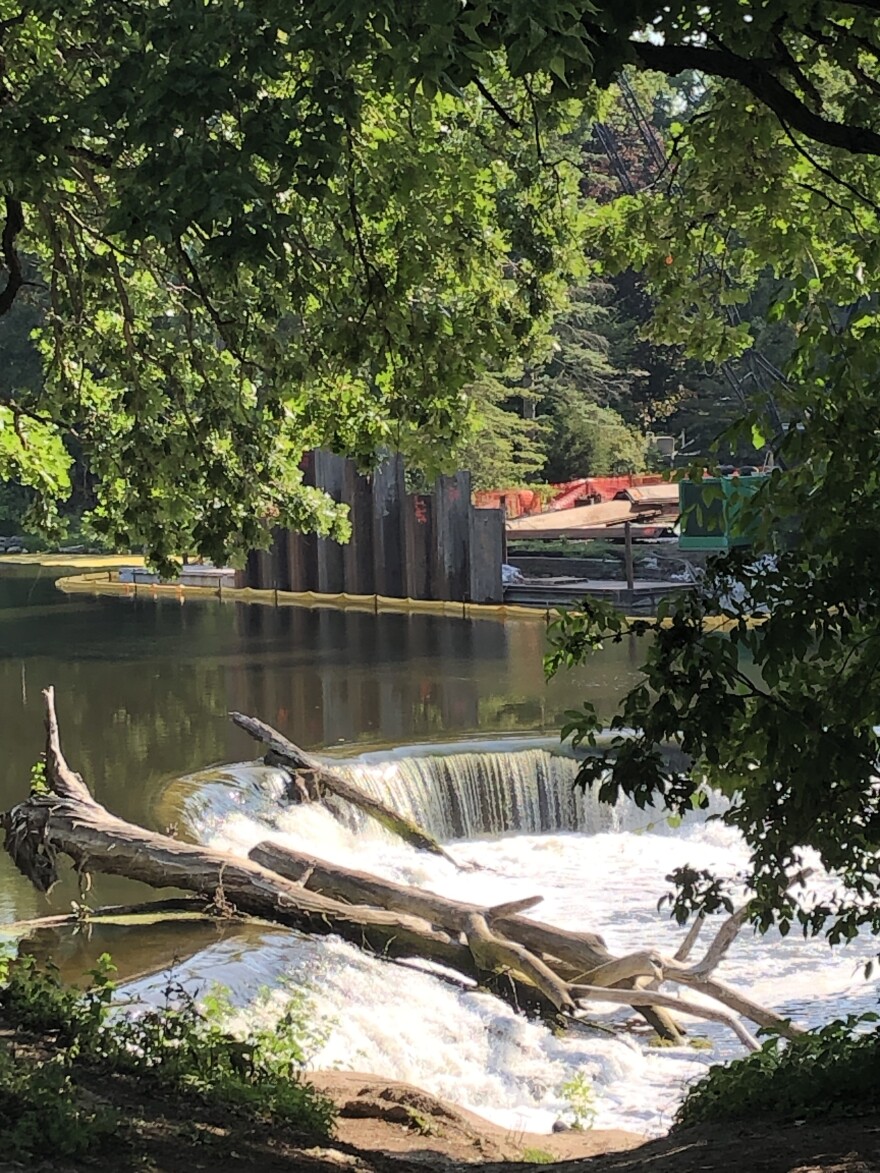The Wisconsin DNR and other groups want to make it easier for fish trying to travel upstream along the Milwaukee River during spawning season.
That’s why crews have been moving earth and water along Kletzsch Dam in Glendale this summer — creating what’s known as a fish passage. Advocates say the fish passage and other projects matter for the health of the river and all that live in and around it.
The Milwaukee River, rippling in the morning light, competes well with the sound of earth movers grinding away nearby. I stand beneath a canopy of majestic oaks above the riverbank with Beth Wentzel, senior project manager with the Milwaukee Metropolitan Sewerage District, and Stacy Hron.
“I’m the Lake Michigan program coordinator with the Wisconsin DNR,” Hron says.

A fish passage is an engineered watery byway allowing fish to swim rather than trying to leap over an impediment, like a dam.
Hron says it took years to set the project in motion. In part, because hundreds of residents worried about how Kletzsch Park would be impacted. For instance, would these trees be removed?
READ Kletzsch Park Dam Project Jammed Up By Public Concern
“There are a lot of complicating factors from a technical … working next to the dam,” Hron says. And the dam itself needed fixing. It was built in 1934 by Civilian Conservation Corps crews for recreational purposes.
Early in its life, swimmers reportedly enjoyed taking a dip in the calm waters above the dam.
Over the decades, loads of sediment accumulated and vegetation had taken hold. Both compromised the safety and stability of the dam. Ten year ago, the DNR ordered Milwaukee County — the dam’s owner —to either repair or remove it.
Hron says planners had to factor in: “Making sure you still have the flow over the dam, allowing a passage way that will have really big fish like lake sturgeon be able to pass through and small fish like northern pike. And then also, yeah, working through what the community wants to see here and there were a lot of folks that were passionate about aspects of the park or aspects of the river,” she says.

It costs $350,000 to shore up the dam. The fish passage is a $2 million project. Ultimately, it was decided the west side of the river, and its trees, would not be touched. Instead, the fish passage will be carved out on the eastern bank. It'll be made up of a series of watery ramps called riffles. Those are interspersed with deeper pools where fish can rest.
The system occupies parts of several city lots.

The MMSD's Beth Wentzel says the passage will be a 475-foot-long loop. That allows for a more gradual transition from below to above the dam. "It will cut all the way back, and then it will meander up further north and then it will come in where you see where you see that sheet pile over there," Wentzel says.

A crew drove a temporary wall of steel sheet pile 20 feet into the earth just above the dam. Wentzel says the to ensure water doesn’t flow through the passage until it’s fully constructed.
“The way it will work is there will be water flowing over the dam as always but a portion of the river’s flow will go through that channel. What we don’t want is for the entire river to flow over there. So that was part of the design process in determining okay how much force going to put on these rocks and how do we size the rocks so that they’re not going to move,” Wentzel says.
Wentzel says the plan also factored the influence of climate into the passage design. “Because we’re expecting that we’ll have higher high flows, lower low flows, longer droughts, more extreme events — considering all of those type of flow events, trying to ensure that fish can make it past this dam in as many different conditions as possible,” she says.
Wentzel anticipates the passage project will be finished by the end of November, “And then people ask, well how are fish going to find it,” she says.
Wentzel who calls herself a fish nerd, says imagine the sensation of wind blowing on your face.
"Kind of the way you can feel which way the wind is blowing on your face. They can figure out which way the water's coming at them. They'll feel some of the water coming straight over the dam, but then they're going to look around for a passage and realize there's water coming through there as well, and then off they go," Wentzel says.
Stacy Hron with the DNR says getting fish past Kletzsch Dam gives them access to another 25 miles of the Milwaukee River, even more miles of tributary streams, plus 2,400 acres of wetlands, "And provide a lot of connectivity for the fish to use the entire stretch all the way up to Grafton," she says.
Still, Wentzel says they’re puzzling out a couple more spots to increase spawning success, starting with a stretch about 3 ½ miles downstream, called Estabrook Falls.
Estabrook Dam, another source of community contention, was removed in 2018.
“The location we’re talking about now is Estabrook Falls, which is right near the beer garden,” Wentzel explains.

The falls aren’t natural. They’re relics of bedrock mining in the river.
“So they mined bedrock out of the river and where they stopped is where you see that drop. Historically fish could get past there, no problem, but now with that left there, it is a problem,” Wentzel says. “So that’s what we’re going to working on: a solution.”
Wentzel says it’s all about reestablishing a life cycle, “To ultimately have more big fish in the river and everybody likes that, right?” she says.
_






